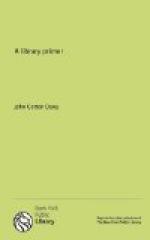The National educational association is the largest organized body of members of the teaching profession in the world. Its annual meetings bring together from 5000 to 15,000 teachers of every grade, from the kindergarten to the university. It includes a number of departments, each devoted to a special branch of educational work. The Library department was established in 1897. It has held successful meetings. It is doing much to bring together librarians and teachers. It is arousing much interest in the subject of the use of books by young people, briefly touched on in the later chapters of this book.
Following the example of the N.E.A., many state and county associations of teachers throughout the country have established library departments. At these are discussed the many aspects of such difficult and as yet unanswered questions as: What do children most like to read? How interest them in reading? What is the best reading for them?
CHAPTER XLVIII
Young people and the schools
If possible give the young people a reading room of their own, and a room in which are their own particular books. These special privileges will not bar them from the general use of the library. Make no age limit in issuing borrowers’ cards. A child old enough to know the use of books is old enough to borrow them, and to begin that branch of its education which a library only can give. The fact that a child is a regular attendant at school is in itself almost sufficient guarantee for giving him a borrower’s card. Certainly this fact, in addition to the signature of parent, guardian, or adult friend, even if the signer does not come to the library, will be guarantee enough.
Teachers should be asked to help in persuading children to make the acquaintance of the library, and then to make good use of it. To get this help from teachers is not easy. They are generally fully occupied with keeping their pupils up to the required scholarship mark. They have no time to look after outside matters.
Visits to teachers in their schoolrooms by librarian or assistant will often be found helpful. Lists of books adapted to schoolroom use, both for the teacher and for pupils, are good, but are very little used when offered, unless followed up by personal work. Brief statements of what the library can do and would like to do in the way of helping on the educational work of the community will be read by the occasional teacher. Teachers can sometimes be interested in a library through the interest in it of the children themselves. The work of getting young people to come to the library and enjoy its books should go hand in hand with the work of persuading teachers to interest children in the library. It is not enough to advertise the library’s advantages in the papers, or to send to teachers a printed statement that they are invited and urged to use the institution;




